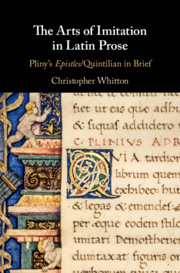Book contents
- The Arts of Imitation in Latin Prose
- The Arts of Imitation in Latin Prose
- Copyright page
- Dedication
- Epigraph
- Frontispiece
- Contents
- Ad lectorem
- Quintilian in Brief, in Brief
- Abbreviations
- Chapter 1 Two Scenes from the Life of an Artist
- Chapter 2 Setting the Stage
- Chapter 3 Brief Encounters
- Chapter 4 Dancing with Dialectic
- Chapter 5 Through the Looking-Glass
- Chapter 6 On Length, in Brief (Ep. 1.20)
- Chapter 7 Letters to Lupercus
- Chapter 8 Studiorum secessus (Ep. 7.9)
- Chapter 9 Docendo discitur
- Chapter 10 Reflections of an Author
- Chapter 11 Quintilian, Pliny, Tacitus
- Chapter 12 Beginnings
- References
- Index locorum
- Index of Greek and Latin Words
- General Index
Chapter 2 - Setting the Stage
Published online by Cambridge University Press: 10 June 2019
- The Arts of Imitation in Latin Prose
- The Arts of Imitation in Latin Prose
- Copyright page
- Dedication
- Epigraph
- Frontispiece
- Contents
- Ad lectorem
- Quintilian in Brief, in Brief
- Abbreviations
- Chapter 1 Two Scenes from the Life of an Artist
- Chapter 2 Setting the Stage
- Chapter 3 Brief Encounters
- Chapter 4 Dancing with Dialectic
- Chapter 5 Through the Looking-Glass
- Chapter 6 On Length, in Brief (Ep. 1.20)
- Chapter 7 Letters to Lupercus
- Chapter 8 Studiorum secessus (Ep. 7.9)
- Chapter 9 Docendo discitur
- Chapter 10 Reflections of an Author
- Chapter 11 Quintilian, Pliny, Tacitus
- Chapter 12 Beginnings
- References
- Index locorum
- Index of Greek and Latin Words
- General Index
Summary
This chapter introduces our two protagonists, their works, and ancient imitatio. It first brings together Quintilian and Pliny as individuals: their lives, careers and personal acquaintance. Pliny twice names Quintilian as his former teacher, but elsewhere implicates him in criticisms of Domitian, in a fine blend of professed allegiance and implicit distancing. Comparison of their views, outlooks and modes of writing suggests similarly nuanced dialectic. I next introduce the Institutio oratoria and suggest that it was more widely read in Pliny’s day than usually supposed. ‘A tale of two Plinies’ takes position in the critical war over the Epistles between ‘intertextualists’ and ‘epistoliteralists’ and shows that the Epistles is far more imitative than either side have supposed, encompassing a wide range of verse (including Callimachus, Terence and Lucretius) and prose (including Herodotus, Sallust and Valerius Maximus). The final section (‘Imitatio on and off the page’) discusses Pasquali, allusion and my preferred term, ‘imitation’; I then situate intertextuality in the broader cultural phenomenon of imitatio, and argue (with a reading of Epistles 1.2) that ancient stylistic and textual imitation was inherently personal and ethical – above all for Pliny.
Keywords
- Type
- Chapter
- Information
- The Arts of Imitation in Latin ProsePliny's <I>Epistles</I>/Quintilian in Brief, pp. 20 - 68Publisher: Cambridge University PressPrint publication year: 2019

